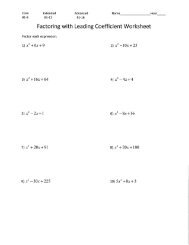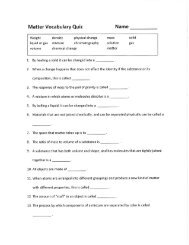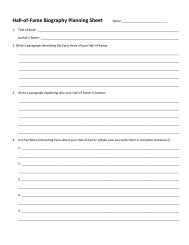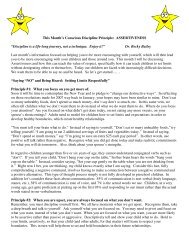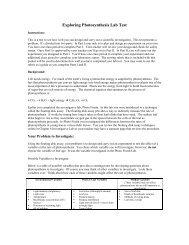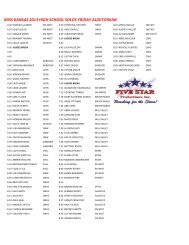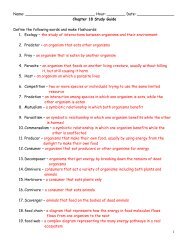Fifth-Sixth grade Flip Charts
Fifth-Sixth grade Flip Charts
Fifth-Sixth grade Flip Charts
You also want an ePaper? Increase the reach of your titles
YUMPU automatically turns print PDFs into web optimized ePapers that Google loves.
“There are one-story intellects, two-story intellects, and three-story intellects with skylights. Allfact collectors who have no aim beyond their facts are one-story men. Two-story men compare,reason, generalize, using the labor of fact collectors as their own. Three-story men idealize,imagine, predict--their best illumination comes from above the skylight.”-Oliver Wendell HolmesThe Kansas Social Studies Assessed Indicators and the Three-Story IntellectThe Social Studies <strong>Flip</strong> <strong>Charts</strong> have been created for the indicators that have been targeted forthe Kansas Assessment in Social Studies. The <strong>Flip</strong> <strong>Charts</strong> are available for all three assessedareas: <strong>grade</strong>s 6, 8 and high school. Assessed Indicators are identified with a cognitive categoryof Application (A) or Knowledge (K). Knowledge is defined as the ability to recognize andrecall social studies definitions, facts, concepts and procedures. Application is defined as theability to use or apply social studies knowledge to interpret, analyze, problem solve, makeinformed decisions, and impact civic participation. To further delineate the range of cognitivedemands of Application and Knowledge, The Kansas State Department of Education (KSDE)and the Social Studies <strong>Flip</strong> Chart Committee encourages teachers to use the Three Story Intellectas a model for cognitive understanding:The First-Story (Knowledge): Imagine the collection of Knowledge –those basic definitions,facts, concepts, procedures, being accumulated in the minds of young students—just as we storefurniture within the basement of our homes. We simply collect and gather these pieces until weget ready to use them in a more sophisticated manner. One might see this first-story as the“Gathering Place.” Cognitive tasks on the first-story might include: describing, matching,reciting, identifying.The Second-Story(Knowledge/Application): This story is the “Processing Place.” Eventually, wemove the furniture we accumulated in the basement up to the second-floor in a pattern that ismeaningful--we decide the painting looks best over the mantel, or the rug works well under thedining room table. This happens, just as students start processing and moving Knowledge (thosefacts, definitions, etc) into meaning patterns. The Second-Story can be perceived as a cognitiveprocess that falls between Knowledge and Application. Cognitive tasks here include: explaining,comparing, classifying, sorting, etc.The Third-Story--Attic (Application): If we were to ask, “where do children like to spend most oftheir time in a house?” The most exciting location proposed would be the attic. The attic iswhere we can look at grandmother’s wedding dress or grandfather’s war medals! Cognitively,the Attic is where students can infer, analyze, judge, predict, estimate, etc. As educators, thechallenge proposed is: How much time are we spending in the Attic in our classrooms? Whathappens when the indicator is asking the question at attic level on the assessment and we havebeen teaching in the basement all year? What do we mean by aligning instruction andstandards to the assessment?Comparison of 3-Story Intellect to KSDE Social Studies Standards generated by Lynn Stanley, Social Studies Consultant, KSDE,September 2006. Resources used for Three Story Intellect:http://www.adrian.edu/~fdetwiler/local/ctwg/threestory.htm & http://www.iwebquest.com/webquestcourse/intellect.htmUTH
Elementary SchoolSS.5.1.2.4kStandard: Civics-Government4. (K) identifies important founding fathers and their contributions (e.g., George Mason, Thomas Jefferson, JamesMadison, George Washington, Benjamin Franklin, Thomas Paine, Samuel Adams, John Adams).Explanation of Indicator:Cognitive Level (K); Three Story Intellect (1) identifies, recognizesMain Concept:Contributions of Founding Fathers to the development of early U.S. GovernmentEmbedded Concepts:Constitution/PreambleDeclaration of IndependenceBill of RightsInstructional Examples/Resources:KWL-American Citizenship TestComplete an SQ3R-using social studies test or the “Citizenship Test”Complete an Opinion Proof T-Chart using PreambleItem Specifications:• Multiple choice, one correct answer• Only the terms with deltas next to them are eligible for assessment.• No information after 1800 is eligible for assessment. Therefore, the Louisiana Purchase and the War of 1812 are not eligiblefor assessment.• The term ‘founding fathers’ is acceptable.• Items should relate to roles as founding fathers, political leaders, or input in starting a government, rather than facts abouteach man beyond his political career.Formative Performance Suggestions:Students create a flip book of Funding Fathers listing contributions in starting a government or listing their political leadershipState Assessment Practice Items:7. Which founding father was the key author of the Declaration of Independence?A) John AdamsB) Benjamin FranklinC) X Thomas JeffersonD) George WashingtonQuestionId: 29983, Standard 1 "1-Civics-Government", Benchmark 2 "2", Indicator "4", Sub Indicator "4k"1
Elementary SchoolSS.5.1.3.4aStandard: Civics-Government4. (A) explains the functions of the three branches of federal government (e.g., legislative-makes laws, executive-enforces laws,judicial-interprets laws).Explanation of Indicator:Cognitive Level (A); Three Story Intellect (2) explains (how/why)Main Concept:Functions of three branches of the federal government of U.S.Embedded Concepts:Legislative branchExecutive branchJudicial branchState/federal governmentHouse of RepresentativesInstructional Examples/Resources:Graphic organizers (mobiles, posters) – classifying each branch3-column organizert-chart (cause/effect)simulations – role play each branch (see benchmark 3, KS standards)collage – illustrate each branchItem Specifications:• Multiple choice, one correct answer• Only the specified concepts associated with each branch of government may be assessed: legislative makes laws; executiveenforceslaws; judicial-interprets laws. Other specific functions of the branches of government may not be assessed, but maybe used in stimuli and distracters.• Visual stimuli are acceptable under this indicator (e.g., web diagrams, bulleted lists, flow charts).Formative Performance Suggestions:Explain specific functions of the three branches by creating a mobile, poster, brochure, PowerPoint2
Elementary SchoolState Assessment Practice Items:6. The diagram below shows some of the powers of the president of the United States.Which power best completes the diagram?A) prints moneyB) X enforces lawsC) judges criminalsD) chooses senatorsQuestionId: 29984, Standard 1 "1-Civics-Government", Benchmark 3 "3", Indicator "4", Sub Indicator "4a"3
Elementary SchoolSS.5.2.2.2kStandard: Economics2. (K) identifies factors that change supply or demand for a product (e.g., supply: technology changes; demand: invention ofnew and substitute goods; supply or demand: climate and weather).Explanation of Indicator:Cognitive Level (K); Three Story Intellect (2) cause/affectMain Concept:Factors that change supply and demandEmbedded Concepts:Colonial events changingGoods/servicesBarter/tradeDivision of laborSpecializationExports/importsSupply/demandScarcityInstructional Examples/Resources:Discuss/brainstorm for assessment (products to self, labor costs, new technologies, climate conditions)Exchange CityJr. Achievement (economics)Mini SocietyKCEEFinancial Fitness – accessed onlineItem Specifications:• Multiple choice, one correct answer• Items should focus on identifying factors that affect the supply or demand of a product. The item should not require detailedanalysis or explanation.• Items should focus only on the factors in the e.g. list.• Items can reference the effect on the price of items but must also refer to changes in demand or supply.• Items should provide a context for the assessed concepts, and not focus on abstract principles of supply and demand (e.g., thesupply of oranges in Florida, the ice storm in California, the demand for wheat in Kansas).• Products selected as examples for items should be <strong>grade</strong> appropriate.• Historical scenarios are acceptable, but must be limited to the colonial era.• The type of climate and weather should be described (e.g., “hot and humid”, not simply “bad” weather).Formative Performance Suggestions:After economic vocabulary is learned—student will write examples in cooperative groups about factors that changesupply/demand during the Colonial Period.4
Elementary SchoolState Assessment Practice Items:10. Which factor would increase the supply of wheat in Kansas?A) higher taxesB) fewer farmhandsC) more pestsD) X improved weatherQuestionId: 29985, Standard 2 "2-Economics", Benchmark 2 "2", Indicator "2", Sub Indicator "2k"5
Elementary SchoolSS.5.2.5.1aStandard: Economics1. (A) - ($) determines the costs and benefits of a spending, saving, or borrowing decision.Explanation of Indicator:Cognitive Level (A); Three Story Intellect (3) evaluates, problem solvesMain Concept:Cost/benefits of spending, saving, borrowingEmbedded Concepts:Decision making skillsConsumerProducerSaverInvestorOpportunity costInstructional Examples/Resources:Current events/economic activityUsing checkbooksWorking with banks in communityAllowanceClass storeStock market gameExchange cityJr. AchievementDecision treesItem Specifications:• Multiple choice, one correct answer• Items aligned to this indicator should be concrete scenarios and should not assess abstract economic concepts. Historicalscenarios should not be used for this indicator.• Scenarios used in items aligned to this indicator should be <strong>grade</strong> appropriate. Students should be asked about situations theywould experience in their own lives.• Visual stimuli are acceptable under this indicator (e.g., charts, diagrams).• Opportunity cost may be used as a type of cost of a spending, saving, or borrowing decision.Formative Performance Suggestions:Results from technology gamesPre/post test (i.e., Jr. Achievement economic unit)t-chart of cost/benefit related to economic simulationState Assessment Practice Items:2. Klara wants to attend a summer camp. In order to save money to attend the camp, she decides to stop buying tickets tothe movies. Which is the main cost of Klara's decision?A) the fee for campB) the time spent at campC) X the time spent at the moviesD) the taxes on the movies missedQuestionId: 29986, Standard 2 "2-Economics", Benchmark 5 "5", Indicator "1", Sub Indicator "1a"6
Elementary SchoolSS.5.3.1.2kStandard: Geography2. (K) locates major physical and political features of Earth from memory (e.g., Boston, Philadelphia, England,France, Italy, Spain, North America, Atlantic Ocean, Pacific Ocean, Yucatan Peninsula, Germany, Aleutian Islands,Bering Strait, Chesapeake Bay, Hudson Bay, Mexico City, Montreal, Netherlands, Norway, Ohio River, Portugal, Quebec City, St.Lawrence River).Explanation of Indicator:Cognitive Level (K); Three story Intellect (1) identifiesMain Concept:Physical/political features of earthEmbedded Concepts:What a physical/political feature isCity, country, continentAtlas work specific to delta items specific to standardsEurope mapInstructional Examples/Resources:Atlas work (map development)Black line masters from s.s. series/to support embedded conceptsNational geographicDaily oral geographyGeography bee (online)Nystrom atlas co.Item Specifications:• Multiple choice, one correct answer• Only the terms with deltas next to them are eligible for assessment.• All items should have a map as a stimulus.• Modern maps are acceptable; historical maps are not.• Items requiring students to identify shaded countries on a map are acceptable for questions about Europe.• Item stems cannot refer to geographic locations not listed as eligible to provide students geographic relative location clues,e.g., “The Appalachian Mountains are located on which continent?”Formative Performance Suggestions:Completed map using delta items from geography benchmark (1)Identifying locations of delta items (Boston, Philadelphia, England, France, Italy, Spain North America, Atlantic ocean, pacificocean)7
Elementary SchoolState Assessment Practice Items:5. The map below shows Europe, with four countries marked A, B, C, and D.Which letter on the map marks the location of Spain?A) AB) X BC) CD) DQuestionId: 29987, Standard 3 "3-Geography", Benchmark 1 "1", Indicator "2", Sub Indicator "2k"8
Elementary SchoolSS.5.4.1.1kStandard: History1. (K) explains how various American Indians adapted to their environment in relationship to shelter and food (e.g., Plains,Woodland, Northwest Coast, Southeast and Pueblo cultures in the period from 1700-1820).Explanation of Indicator:Cognitive Level (K); Three Story Intellect (2) explains (how/why)Main Concept:American Indians: food, shelter, adapting to environmentEmbedded Concepts:Types of housesFood types/resourcesNatural resourcesLifestylesInstructional Examples/Resources:Dioramas-specific areasVenn diagrams-regional differences, cultural differencesMap work-where tribes were locatedItem Specifications:• Multiple choice, one correct answer• Items developed under this indicator should use only the specific regional/cultural names listed in the indicator.• Items should not require students to have knowledge of specific American Indian tribes.• ‘Teepee’ should be used instead of ‘tipi.’• Stimuli are not required for this item.• Paintings may be used for clarity, as long as the question does not require application of the concept and is limited toidentification (e.g., a painting of a tribe with a teepee, asking what type of shelter is shown in the painting).Formative Performance Suggestions:Using rubric with dioramaMap–drawing sheltersGraphic organizerState Assessment Practice Items:4. Which group of American Indians built adobe shelters on cliffs to protect themselves from heat and enemies?A) PlainsB) X PuebloC) WoodlandD) Northwest CoastQuestionId: 29988, Standard 4 "4-History", Benchmark 1 "1", Indicator "1", Sub Indicator "1k"9
Elementary SchoolSS.5.4.1.3aStandard: History3. (A) compares the motives and technology that encouraged European exploration of the Americas (e.g., motives: trade,expansion, wealth, discovery; technology: improved ship building, sextant, cartography).Explanation of Indicator:Cognitive Level (A); Three Story Intellect (3) generalizesMain Concept:Motives/technology of European exploration of AmericasEmbedded Concepts:European exploration and tradingFrance, Spain, EnglandTechnology for the European exploration time periodVocabularyInstructional Examples/Resources:Motives—t-chart illustrating their motivesTechnology—web graphic organizer (improved ship building, sextant, cartography)Item Specifications:• Multiple choice, one correct answer• Items aligned to this indicator should provide some comparison between the European powers.• As an application indicator, items should require students to do more than identify individuals, countries, and their goals.• Only the motives and technologies listed in the indicator are assessable.• Visual stimuli are acceptable under this indicator (e.g., Venn diagrams, bulleted lists, web diagrams, flow charts).• The astrolabe is not eligible for assessment, but it may be used in stimuli or distracters.• Religious freedom is not assessable, but it may be used in stimuli.Formative Performance Suggestions:Performance item – student presentations (PowerPoint could be used) of various European (French, Spanish, English) explorers(their motives and technology used)10
Elementary SchoolState Assessment Practice Items:9. The diagram below describes reasons a European country explored the Americas.Which country best completes the diagram?A) X SpainB) RussiaC) EnglandD) the NetherlandsQuestionId: 29989, Standard 4 "4-History", Benchmark 1 "1", Indicator "3", Sub Indicator "3a"11
Elementary SchoolSS.5.4.2.3kStandard: History3. (K) describes political and economic structures in the New England, Middle, and Southern Colonies (e.g., political: House ofBurgesses, town meetings, colonial forms of representation; economics: agriculture, trade).Explanation of Indicator:Cognitive Level (K); Three Story Intellect (2) classifiesMain Concept:Political/economic structures in New England, Middle and Southern coloniesEmbedded Concepts:New England regionsHouse of BurgessesTown meetingsColonial forms of representationEconomicsAgricultureTradeInstructional Examples/Resources:Map skills—what state fits in each colonyDirect teaching—political/economic structuresConnection between different colonial regions3-column chart graphic organizerItem Specifications:• Multiple choice, one correct answer• Items aligned to this indicator must focus on the regional groups of the colonies and not on the political and economicdevelopments of specific colonies; for example, town meetings must be associated with the New England colonies, notMassachusetts.• New England Colonies: Massachusetts, Rhode Island, Connecticut, New Hampshire.• Middle Colonies: New York, New Jersey, Pennsylvania, Delaware.• Southern Colonies: Maryland, Virginia, North Carolina, South Carolina, Georgia.• Stimuli are discouraged for this indicator.• The “House of Burgesses” may be referred to as the “Virginia House of Burgesses.”Formative performance Suggestions:Map work, flip book, PowerPoint, poster, brochure of New England, Middle and Southern colonies with political and economicstructureWrite/exchange postcards describing economic and political lifeState Assessment Practice Items:8. Which was the first representative assembly in the American colonies?A) Stamp Act CongressB) X Virginia House of BurgessesC) Continental CongressD) Massachusetts General CourtQuestionId: 29990, Standard 4 "4-History", Benchmark 2 "2", Indicator "3", Sub Indicator "3k"12
Elementary SchoolSS.5.4.3.1kStandard: History1. (K) describes the causes of the American Revolution (e.g., Proclamation of 1763, Intolerable Acts, Stamp Act,taxation without representation).Explanation of Indicator:Cognitive Level (K); Three Story Intellect (2) cause/affectMain Concept:Causes of American RevolutionEmbedded Concepts:Proclamation 1763Intolerable ActsStamp ActsTaxation without representationInstructional Examples/Resources:Write a book (put in own table of contents)Expository report on each embedded conceptMobile on causes from American RevolutionReading of historical novelsReading a timeline in social studies textItem Specifications:• Multiple choice, one correct answer• Only the causes of the American Revolution listed in the indicator are eligible for assessment.• Stimuli are not required or encouraged for this indicator.• Students should not be expected to know the exact dates of specific legislation (e.g., when the Stamp Act waspassed).Formative Performance Suggestions:Flowchart of events for American RevolutionGraphic organizer web—causes of American Revolutiont-chart—causes and effectsState Assessment Practice Items:13
Elementary SchoolSS.5.4.3.6kStandard: History6. (K) describes how the Constitutional Convention led to the creation of the United States Constitution (e.g., GreatCompromise, Three-<strong>Fifth</strong>s Compromise).Explanation of Indicator:Cognitive Level (K); Three Story Intellect (1) describesMain Concept:Describe how the constitutional convention led to the creation of the U.S. ConstitutionEmbedded Concepts:Great CompromiseArticles of Confederation3/5 CompromiseVirginia PlanNew JerseyPopulation of state vs. size of stateInstructional Examples/Resources:Text structure—highlighting main ideas, detailsVideos—review for state assessments in 6 th <strong>grade</strong> (Bill of Rights, Constitution videos)D.K./eyewitness readersItem Specifications:• Multiple choice, one correct answer• Only the concepts ‘the Great Compromise’ and the ‘Three-<strong>Fifth</strong>s Compromise’ are eligible for assessment under thisindicator.• The “Three-<strong>Fifth</strong>s Compromise” must be written as such. The “3/5th Compromise” is not acceptable usage.Formative Performance Suggestions:Video quiz—teacher created materialsConcept map—student explainsDivide class into two groups (representing New Jersey/Virginia Plan); do tug-or-warState Assessment Practice Items:3. At the Constitutional Convention in 1787, the Great Compromise addressed the problem of howA) presidents are elected.B) individuals are granted citizenship.C) X states are represented in Congress.D) justices are appointed to the Supreme Court.QuestionId: 29991, Standard 4 "4-History", Benchmark 3 "3", Indicator "6", Sub Indicator "6k"14
Elementary SchoolSS.5.4.4.1aStandard: History1. (A) uses historical timelines to trace the cause-and-effect relationships between events in different places during the sametime period (e.g., Colonial America and England).Explanation of Indicator:Cognitive Level (A); Three Story Intellect (3) concludesMain Concept:Using timelines to trace cause and effect between events in different places during same time periodEmbedded Concepts:Interpreting timelinesRelationship between England and colonial America (1600s-1700s)Instructional Examples/Resources:t-chart—compare/contrast colonial America and Englandconstruct horizontal and vertical timelineexpository—research (i.e., Boston Tea Party-econ., King George, red coats)read/teach timeline in social studies textItem Specifications:• Multiple choice, one correct answer• Items must focus on the relationship between colonial America and England.• A cause-and-effect relationship must be established within the item. Items may use events during the 1600s and the 1700s todemonstrate the cause-and-effect relationship.• When using a timeline, a cause-and-effect relationship must be the focus of the question.• Timelines may be oriented horizontally or vertically.Formative Performance Suggestions:Readers’ theatre—from expository researchFlow chart—flow of events to apply (or analyze) to timeline15
Elementary SchoolState Assessment Practice Items:1. The timeline below shows some important events that took place during the colonial era.Which letter on the timeline marks Parliament's passage of the Stamp Act, one of the first attempts to make the colonistspay for the defense of the colonies?A) X AB) BC) CD) DQuestionId: 29992, Standard 4 "4-History", Benchmark 4 "4", Indicator "1", Sub Indicator "1a"16
Elementary SchoolSS.6.1.4.1aStandard: Civics-Government1. (A) compares and contrasts the rights of people living in ancient Greece (Sparta and Athens) and ClassicalRome with the modern United States.Explanation of Indicator:Cognitive Level (A); Three Story Intellect (3) evaluates, speculates, generalizesMain Concept:Compare/contrast rights of people in ancient Greece, Classical Rome, with modern U.S.Embedded Concepts:Ancient Greece (Sparta/Athens)Ancient RomeModern U.S.Instructional Examples/Resources:Wax museum (or dinner party) of famous personalities from Ancient Greece, Rome, modern U.S.3-column chart G.O.Item Specifications:• Multiple choice, one correct answer• Only rights may be assessed under this indicator.• Visual stimuli are acceptable under this indicator (e.g., Venn diagrams, web diagrams).• Comparisons must be drawn between the modern United States and one of the other two civilizations.• Comparisons may not be drawn between ancient Greece and classical Rome.• For purposes of assessment under this indicator, only the time period of the Roman Republic, not the RomanEmpire, will be covered for classical Rome.Formative Performance Suggestions:Venn diagramRubric for wax museum/dinner party/oral presentationState Assessment Practice Items:17
Elementary SchoolSS.6.1.5.1kStandard: Civics-Government1. (K) identifies the basic features of systems of government (e.g., republic, democracy, monarchy, dictatorship, oligarchy,theocracy).Explanation of Indicator:Cognitive Level (K); Three Story Intellect (1) identifiesMain Concept:Basic features of systems of governmentEmbedded Concepts:RepublicDemocracyMonarchyOligarchyDictatorshipTheocracyInstructional Examples/Resources:<strong>Flip</strong> book—picture journal interpreting various systems of governmentPoster“act it out” for a day—types of governmentItem Specifications:• Multiple choice, one correct answer• Only the government systems identified in the e.g. list are eligible for assessment.• The use of stimuli is discouraged for this indicator.• ‘Republic’ and ‘oligarchy’ should not appear in the same item if one of them is being assessed. The Roman Republic was anoligarchic republic and this may confuse students. However, both terms may be used as distracters in the same item.• ‘Monarchy’ and ‘dictatorship’ should not appear in the same item if one of them is being assessed. The similarity of monarchsand tyrants (dictators) was very common in the ancient world. Both terms may be used as distracters in the same item,however.Formative Performance Suggestions:<strong>Flip</strong> book (or poster)—completion of vocabularyMatching vocabulary testState Assessment Practice Items:21. In which form of government do the people elect their representatives?A) X republicB) monarchyC) aristocracyD) dictatorshipQuestionId: 29993, Standard 1 "1-Civics-Government", Benchmark 5 "5", Indicator "1", Sub Indicator "1k"18
Elementary SchoolSS.6.2.1.1kStandard: Economics1. (K) explains how scarcity of resources requires communities and nations to make choices about goods and services (e.g.,what foods to eat, where to settle, how to use land).Explanation of Indicator:Cognitive Level (K); Three Story Intellect (2) explains (how/why)Main Concept:Scarcity of resources—nations making good choices about goods/servicesEmbedded Concepts:Natural resourcesClimate/landformsAncient civilizationsBasic needsInstructional Examples/Resources:Ancient civilization – why they began, where they did (i.e., major water sources); social studies text structure/analyze maps onancient civilizationsTeacher directed – brainstorm class list of good and services using natural resourcesItem Specifications:• Multiple choice, one correct answer• Items written to this indicator should focus on the concept of scarcity.• Items written to this indicator must be placed in the context of ancient history.• Visual stimuli are discouraged under this indicator.Formative Performance Suggestions:Describe in written summary about choices an ancient civilization on natural resources“A Day in the Life of ____” journal entry on choices about how goods and services are effected by natural resourcesState Assessment Practice Items:11. Which best explains why people in ancient Greece focused on overseas trading rather than farming?A) The land was too marshy to grow enough crops.B) X The land was too mountainous to grow enough crops.C) The climate was too rainy to grow enough crops.D) The temperature was too high to grow enough crops.QuestionId: 29994, Standard 2 "2-Economics", Benchmark 1 "1", Indicator "1", Sub Indicator "1k"19
Elementary SchoolSS.6.2.3.2kStandard: Economics2. (K) identifies barriers to trade among nations (e.g., treaties, war, transportation, geography).Explanation of Indicator:Cognitive Level (K); Three Story Intellect (1) identifiesMain Concept:Identifies barriers to trade among nationsEmbedded Concepts:TreatiesWarTransportationGeographyCurrencyInterdependent worldReligionTariffConsumerSaverProducerInvestorInstructional Examples/Resources:Vocabulary as listed in embedded concepts/econ. unitTeach in conjunction with units on ancient civilization and with whom there societies tradedItem Specifications:• Multiple choice, one correct answer• Stimuli are not required or encouraged under this indicator.• Items for this indicator may be placed within the context of ancient history.Formative Performance Suggestions:Student written multiple choice testCooperative group – listing barriers to trade among nations, and why trade routes are importantState Assessment Practice Items:17. Trade routes between ancient Egypt and Nubia were mainly affected by which geographic feature?A) junglesB) X desertsC) steppesD) mountainsQuestionId: 29995, Standard 2 "2-Economics", Benchmark 3 "3", Indicator "2", Sub Indicator "2k"20
Elementary SchoolSS.6.3.1.1aStandard: Geography1. (A) explains and uses map titles, symbols, cardinal and intermediate directions, legends, latitude and longitude.Explanation of Indicator:Cognitive Level (A); Three Story Intellect (3) usesMain Concept:Explains and uses mapsEmbedded Concepts:Map titlesCardinal/intermediateDirectionsLegendsLatitude/longitudeInstructional Examples/Resources:Atlas/map workMap scavenger huntsWeb questsReading different types of mapsThinkquest.orgNational Geography websiteItem Specifications:• Multiple choice, one correct answer• All items should use a map as a stimulus.• Items should require students to use the map to answer the question.• The use of letters to identify the locations on the map is acceptable.• Modern maps are acceptable.• Historical maps from the ancient and classical eras are acceptable.• The use of scale to determine distances between cities is acceptable.Formative Performance Suggestions:Written summary of directions (i.e., directions from Athens to Sparta in your chariot); include latitude/longitude directions; drawmap/legendReading different types of maps21
Elementary SchoolState Assessment Practice Items:13. The map below shows Europe and North Africa, with two countries labeled.If a person were traveling directly from Italy to Egypt, he or she would be going in which direction?A) northeastB) northwestC) X southeastD) southwestQuestionId: 29996, Standard 3 "3-Geography", Benchmark 1 "1", Indicator "1", Sub Indicator "1a"22
Elementary SchoolSS.6.3.2.3kStandard: Geography3. (K) identifies and describes the location, landscape, climate, and resources of early world civilizations (e.g., Mesopotamia,Egypt, India, China, Greece, Rome, Middle/South America, Western Europe, West Africa, Japan).Explanation of Indicator:Cognitive Level (K); Three Story Intellect (2) distinguishesMain Concept:Identifies and describes location, landscape, climate, and resources of early world civilizations.Embedded Concepts:Delta areas and Mesopotamia, Egypt, India, China, Greece, Rome, Middle/South AmericaInstructional Examples/Resources:Develop web for world civilizationsMap skills for each civilizationCooperative group—poster/collageItem Specifications:• Multiple choice, one correct answer• Only civilizations with deltas next to them are eligible for assessment.• Items written to this indicator may use maps to designate the location of civilizations.• Stimuli are acceptable but not necessary for this indicator. If a diagram is used, it should not require analysis that would makethe item application. For instance, in a web diagram, the four concepts on the spokes should be exclusive to the civilization atthe hub.• In the answer choices, a proper noun should be used to describe civilizations, instead of an adjective modifying civilization(e.g., Egypt, not Egyptian civilization).• Ancient maps—not modern maps—should be used to indicate the location of civilizations. Physical maps may also be used,as long as they do not have any modern borders marked on them.Formative Performance Suggestions:Graphic organizerState Assessment Practice Items:20. The ancient civilization of Mesopotamia was locatedA) in the Nile River valley.B) on the Arabian Peninsula.C) X in the Fertile Crescent.D) on the Indian Subcontinent.QuestionId: 29997, Standard 3 "3-Geography", Benchmark 2 "2", Indicator "3", Sub Indicator "3k"23
Elementary SchoolSS.6.3.4.2kStandard: Geography2. (K) describes the forces and processes of conflict and cooperation that divide or unite people (e.g., uneven distribution ofresources, water use in ancient Mesopotamia, building projects in ancient Egypt and Middle/South America, the Greekcity-states, empire building, movements for independence or rights).Explanation of Indicator:Cognitive Level (K); Three Story Intellect (2) infersMain Concept:Describe the forces and processes of conflict and cooperation that divide or unite peopleEmbedded Concepts:Conflict vs. cooperationGovernment systemsScarcityNatural/human resourcesUneven distribution of resourcesWater use in ancient MesopotamiaBuilding projects in ancient Egypt and Middle/South AmericaGreek city-states, empire buildingsMovements for independence or rightsInstructional Examples/Resources:T-chart G.O.Technology—inspiration of designs (graphic organizer)Item Specifications:• Multiple choice, one correct answer• Only the terms with deltas next to them are eligible for assessment under this indicator.• Stimuli are not necessary or encouraged under this indicator.• Uneven distribution of resources may be applied to all of the ancient civilizations listed, but items must be historicallyaccurate and <strong>grade</strong> appropriate.• Items assessing the Greek city-states may focus on sources of unity and conflict (e.g., wars such as the Persian andPeloponnesian; Olympic Games)• Items assessing ancient Egypt and Middle/South America should focus on examples of building projects requiring cooperationor unity (e.g., building of pyramids, tombs, irrigation canals).Items assessing ancient Mesopotamia may should focus on wateruse (e.g., irrigation canals)Formative Performance Suggestions:Written summary after t-chart is produced about each civilizationRubric with inspiration technology project (G.O.)PowerPoint presentationStudent directed multiple choice testVideo news cast – summarize civilization24
Elementary SchoolState Assessment Practice Items:14. How did the pharaohs organize and unite the efforts of the Egyptian people?A) X They paid laborers to build the pyramids.B) They founded colonies throughout the region.C) They provided a written constitution to the government.D) They established a public school system for the peasants.QuestionId: 29998, Standard 3 "3-Geography", Benchmark 4 "4", Indicator "2", Sub Indicator "2k"25
Elementary SchoolSS.6.4.1.2aStandard: History2. (A) compares the origin and accomplishments of early river valley civilizations (e.g., Tigris and Euphrates (Mesopotamia):city-states, Hammurabi’s code; Nile Valley (Egypt): Pharaoh, centralized government; Indus Valley (India): Mohenjo Daro;Huang He (China): Shang Dynasty).Explanation of Indicator:Cognitive Level (A); Three Story Intellect (3) generalizesMain Concept:Compare origin/accomplishments of early river valley civilizationsEmbedded Concepts:Tigris/Euphrates (Mesopotamia): city-statesHammurabi codeNile River (Egypt): PharaohCentralized governmentIndus Valley (India): Mohenjo DaroHuang He (China): Shang DynastyInstructional Examples/Resources:Venn diagram (compare/contrast 2 or 3 list civilizations)Web-graphic organizers – as civilization taught: cloze activities, jeopardy, concentrationCrossword puzzle – puzzlemaker.comItem Specifications:• Multiple choice, one correct answer• Only the concepts listed after each specific civilization in the indicator are eligible for assessment.• Visual stimuli are acceptable under this indicator (e.g., web diagrams, Venn diagrams).Formative Performance Suggestions:Matching tests – identify accomplishments related to ancient civilization of origin26
Elementary SchoolState Assessment Practice Items:16. The diagram below shows the achievements of a certain ancient civilization.Which ancient civilization best completes the diagram?A) IndiaB) RomeC) ChinaD) X EgyptQuestionId: 29999, Standard 4 "4-History", Benchmark 1 "1", Indicator "2", Sub Indicator "2a"27
Elementary SchoolSS.6.4.2.1kStandard: History1. (K) compares and contrasts characteristics of classic Greek government (e.g., city-states, slavery, rule by aristocrats andtyrants, Athens: development of democracy, Sparta: city’s needs come first).Explanation of Indicator:Cognitive Level (K); Three Story Intellect (1) identifiesMain Concept:Compare/contrast characteristics of classic Greek governmentEmbedded Concepts:City-statesSlaveryRule by aristocrats and tyrantsAthens – development of democracySparta – city’s needs come firstInstructional Examples/Resources:t-chart graphic organizerweb graphic organizer – technology inspirationItem Specifications:• Multiple choice, one correct answer• Only those concepts identified in the e.g. list are eligible for assessment.• Only Sparta and Athens are eligible for assessment as specific Greek city-states. The specific details of other Greek city-states(e.g., Argos, Thebes) are not assessable.• Under Athens, the concept of democracy is assessable. Major historical figures from the time period are not assessable.Formative Performance Suggestions:Venn diagram – compare life in Athens vs. SpartaDiary entries – students take one city-state, and explain why their life is bestState Assessment Practice Items:19. In which classical Greek city-state did democracy begin?A) SpartaB) CorinthC) X AthensD) ThebesQuestionId: 30000, Standard 4 "4-History", Benchmark 2 "2", Indicator "1", Sub Indicator "1k"28
Elementary SchoolSS. 6.4.2.4kStandard: History4. (K) describes key characteristics of classical Roman government (e.g., Roman Republic: senate, consuls, veto, written law;Roman Empire: emperors, expansion).Explanation of Indicator:Cognitive Level (K); Three Story Intellect (1) describesMain Concept:Describes key characteristics of classical Roman governmentEmbedded Concepts:Roman RepublicSenateConsulsVetoWritten lawRoman EmpireEmperors expansionInstructional Examples/Resources:Expository reports – ancient Roman life<strong>Flip</strong> books – embedded concept termsCollage of ancient RomePersuasive writing comparing/contrasting Ancient Greece to Ancient Rome to determine which culture was more significantItem Specifications:• Multiple choice, one correct answer• Roman civilization concepts other than those listed are not acceptable.• Graphics and other stimuli are not necessary or encouraged for this indicator.Formative Performance Suggestions:Scroll of ancient Roman embedded concept itemsMatching test on embedded concept termsAct out Roman senateState Assessment Practice Items:15. In the Roman Republic, who were elected by the people to serve for one year as the chief officers of the governmentand the military?A) X consulsB) tribunesC) tyrantsD) gladiatorsQuestionId: 30001, Standard 4 "4-History", Benchmark 2 "2", Indicator "4", Sub Indicator "4k"29
Elementary SchoolSS.6.4.2.6aStandard: History6. (A) examines the central beliefs of Christianity, Hinduism, Buddhism, Judaism, and Islam.Explanation of Indicator:Cognitive Level (A); Three Story Intellect (3) generalizesMain Concept:Examines central beliefs of Christianity, Hinduism, Buddhism, Judaism, IslamEmbedded Concepts:ChristianityHinduismBuddhismJudaismIslamInstructional Examples/Resources:Brochure – 5 major religionsWeb quest/definition searchVocabulary/terminology – text structure (highlighting)World Religions by Mary Pope OsbornField trips to different areas of worshipItem Specifications:• Multiple choice, one correct answer• Only the religions specified in the indicator are eligible for assessment.• Other religions, if well known, may be used as distracters (e.g., Taoism, Shintoism).• Visual stimuli are acceptable under this indicator (e.g., web diagrams).• The use of photographs of modern practices of the religions is acceptable. Items should require students to analyze thephotograph.Formative Performance Suggestions:PowerPoint – 5 major religions30
Elementary SchoolState Assessment Practice Items:18. The diagram below shows some of the beliefs of a religion.Which religion best completes the diagram?A) X IslamB) JudaismC) HinduismD) BuddhismQuestionId: 30002, Standard 4 "4-History", Benchmark 2 "2", Indicator "6", Sub Indicator "6a"31
Elementary SchoolSS.6.4.2.9kStandard: History9. (K) describes key accomplishments of ancient China (e.g., Great Wall of China, Shi Huangdi, dynastic cycle, Mandate ofHeaven, Taoism, Confucianism, civil service, Silk Road).Explanation of Indicator:Cognitive Level (K); Three Story Intellect (1) describesMain Concept:Describes key accomplishments of ancient ChinaEmbedded Concepts:Great Wall of ChinaShi HuangdiDynastic cycleMandate of HeavenTaoismConfucianismCivil serviceSilk RoadInstructional Examples/Resources:Text – highlighting main idea and detailsReview – outlining, clozone activityExpository research reports on embedded conceptsItem Specifications:• Multiple choice, one correct answer• Only the specific concepts identified in the e.g. list are eligible for assessment. Other accomplishments of ancient China arenot eligible for assessment under this indicator.• Items should be factually recall-oriented and should not expect students to have detailed knowledge of Chinese history.• Taoism may be referred to as a religion.• Comparison with other civilizations is acceptable (e.g., “In which civilization was Confucianism developed?”).Formative Performance Suggestions:Poster project of embedded conceptsState Assessment Practice Items:22. In ancient China, an emperor had the authority to rule underA) nirvana.B) X the Mandate of Heaven.C) monotheism.D) the Ten Commandments.QuestionId: 30003, Standard 4 "4-History", Benchmark 2 "2", Indicator "9", Sub Indicator "9k"32
Elementary SchoolSS.6.4.4.1aStandard: History1. (A) examines a topic in World history to analyze changes over time and makes logical inferences concerning cause-andeffect(e.g., spread of ideas and innovations, rise and fall of empires).Explanation of Indicator:Cognitive Level (A); Three Story Intellect (3) evaluatesMain Concept:Examines a topic in world history to analyze changes over time and makes logical inferences concerning cause and effectEmbedded Concepts:Spread of ideas and innovationsRise and fall of empiresInstructional Examples/Resources:Write a newspaper article – analyze changes over time in world historyWeb quest – student use web quest questions from self-directed siteSequencing/cartoon stripItem Specifications:• Multiple choice, one correct answer• Items aligned to this indicator may use examples from the sixth-<strong>grade</strong> history curriculum.• Topics must have a demonstrative cause-and-effect relationship.• Topics must focus either on the spread of ideas and innovations or the rise and fall of empires.• Visual stimuli are acceptable under this indicator (e.g., cause-and-effect diagrams).Formative Performance Suggestions:Using a tableWritten summary – drawing conclusions about an ancient world history culturet-chart – then and now33
Elementary SchoolState Assessment Practice Items:12. The cause-and-effect diagram below shows events that led to the fall of Athens in 404 b.c.Which best completes the diagram?A) X War breaks out with Sparta.B) Slave revolts weaken the political system.C) Alexander the Great declares war on Greece.D) Long droughts destroy agricultural production.QuestionId: 30004, Standard 4 "4-History", Benchmark 4 "4", Indicator "1", Sub Indicator "1a"34






